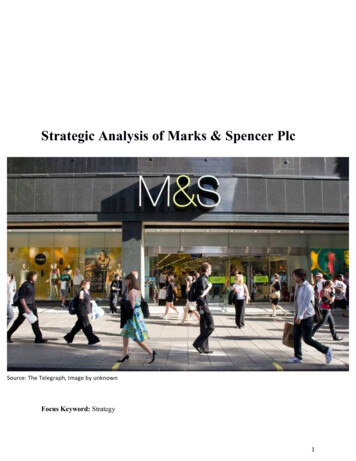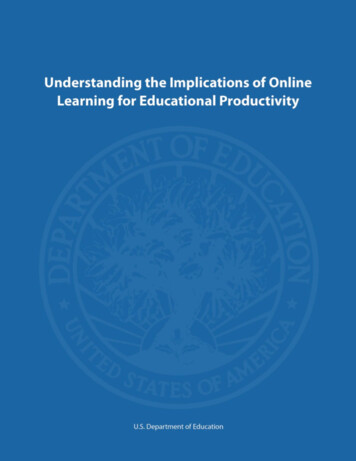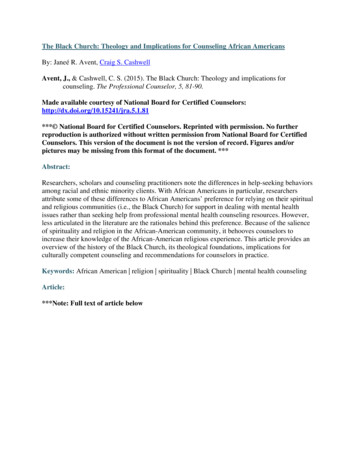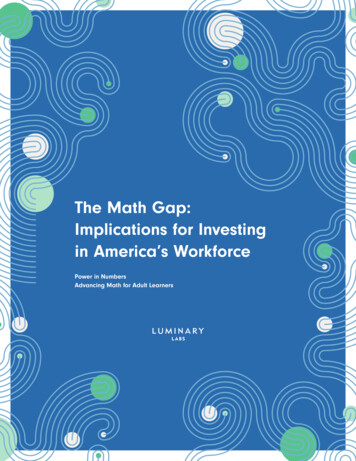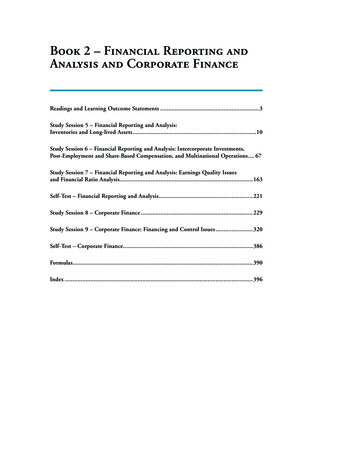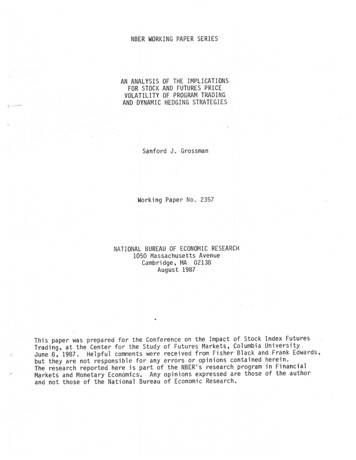
Transcription
NBER WORKING PAPER SERIESAN ANALYSISFOR STOCKVOLATILITYAND DYNAMICOF THE IMPLICATIONSAND FUTURES PRICEOF PROGRAM TRADINGHEDGING STRATEGIESSanford 3. GrossmanWorking Paper No. 2357NATIONAL BUREAU OF ECONOMIC RESEARCH1050 Massachusetts AvenueCambridge, MA 02138August 1987This paper was prepared for the Conference on the Impact of Stock Index FuturesTrading at the Center for the Study of Futures Markets, Columbia University.June 8, 1987. Helpful comments were received from Fisher Black and Frank Edwards,but they are not responsible for any errors or opinions contained herein.The research reported here is part of the NBER's research program in FinancialMarkets and Monetary Economics. Any opinions expressed are those of the authorand not those of the National Bureau of Economic Research.
NBER Working Paper #2357August 1987.An Analysis of the Irlications for Stock Futures Price Volatilityof Program Trading and Dynamic Hedging StrategiesABSTRACT'Recent àdvancès tn financiat theory hive created an understanding, of the'énv1ronmentsin which .a real security cant be synthesized by'I dynamic trading3. H. '. strategy ina'crucialarisk free asset and other securities. We contend. that there isdistinction between a lynthetic security and a real security. In particularthe notion that a real security is redundant when it' can be synthesized by a'dynamic trAding'strategy Ignores" the: i nfoirmational role of rSal "securities markets.'The replacement of a real security by synthetic strategies may. in'itself causeenough uncertainty"about the priëe volatility of the' underlying secUrity, thatthe real security is no longer redundant.Portfol to iniurance provides, a 'good. éxanqle of 'the 'difference between asynthetic security and a real security. One fonn. of portfolio insurance usesatrading strategy in risk' free *ecuritià"(Mcash"), arid Index futures.a'Eui'opeanto synthesizeput on the underlying'portfolio.' In 'the 'Abténce 'of a real,'tradedptitoptidn (of the appropriate striking p'riàe,andmaturity) there 1111 be less'tnlonnation ibout the future price volatility associated with currentdynamichedging strategies. There will thus be less information transmitted to thosepeople who could make capital available to liquidity providers. It will thereforebe more difficult for the market to absorb the trades implied by the dynannchedging strategies. In-effect, 'the stockil.:future :p.rjce:: volatility 'can risebecause of a:current lack of infàrmation about the extent toMiich.dynamic hedgingstrategies 'areinplace.,:'''Sanford,J .GrossmanDepartmeht, of EconOmicsPrinceton' University,Princeton, NJ 08544
—1--1. INTRODUCTIONThe introduction of futures and options markets in stockindexes is strongly associated with the use of programmedtrading strategies.Such strategies are used for spot/futuresarbitrage, market timing, and portfolio insurance. It is thislast use of programmed trading strategies that raisesfascinating theoretical questions, the answers to which may havepractical importance for understanding the impact of suchstrategies on the volatility of stock and futures prices.Recent advances in financial theory have created anunderstandingof the environments inwhicha real security canbe synthesized by a dynamic trading strategy in a risk freeasset and other securities. 1securities has been'rhe proliferation of newmade possible, in part, by this theoreticalwork. 'The issuer of a new security canpricethe security basedstream of the newon its ability to synthesize the returnssecurity using a dynamic trading strategy in existingsecurities, futures and options. This USe of dynamic tradingstrategies has been extended even further by eliminating the"new" security altogether and just selling the dynamic hedgingPortfoi:Lo insurance is the best example ofstrategy directly.thelatter phenomenon.Herein we contend that there is a crucial distinctionThe seminal contribution is the Black—Scholes (1973)option pricing approach, whereby it is shown how a dynamictrading strategy in a stock and risk free asset can reproduce aEuropean call or put option on the stock.
—2—between a synthetic security and a real security. In particularthe notion that a real security is redundant when it can besynthesized by a dynamic trading strategy ignores theinformational role of real securities markets,2 The prices ofreal securities convey important information to marketparticipants, and this information will not be conveyed if thereal security is replaced by synthetic trading strategies. Inparticular the replacement of a real security by syntheticstrategies may in itself cause enough uncertainty about theprice volatility of the underlying security that the realsecurity is no longer redundant.Portfolio insurance provides a good example of thedifference between a synthetic security and a real security.One form of portfolio insurance uses a trading strategy in riskfree securities ("cash") and index futures to synthesize aEuropean put on the underlying portfolio. If a put was tradedon a securities market, then the price of the put would revealimportant information about the desire of people to sell stockconsequent to adverse future price moves.3For example, ifeveryone in the economy would like to get out of stocks beforethe price falls by more than 25%, then the price of such a putoption would be very high.2 See Grossman (1977)If only a few holders of stocksfor an elaboration of theinformational role of securities and futures prices.Throughout this paper "stock" is often usedinterchangeably with "stock index" to represent a portfolio ofrisky assets.
-.3 —desiredsuch protection then the put option's market price wouldbe low. The put's price thus reveals informationabout thefraction of people with plans to get out of (or into) stocks inthe future,The put's price reveals the extent to which thestrategies of people can cohere in the future.By showingpeople the true cost of their planes it may discourage peoplefrom attempting to purchase too much insurance in exactly thosecircumstances when the dynamic hedging strategy would raisestock price volatility.4All of the above informational consequences of trading in areal security are absent if the real security is replaced bydynamic hedging strategies alone.How does a purchaser of agiven strategy (such as a synthetic put) know the cost ofinsurance? Surely the cost depends on how many other people areplanning to carry out similar stock selling and purchasing plansin the future. What mechanism exists to aggregate across peoplethe information about future trading plans which will determinethe cost of the current insurance strategy?The marketing of strategies rather than securities has farreaching implications for the volatility of the underlying stockand futures markets.There is no market force or priceinformation which ensures that stratecUes can be implemented, orwhich informs the user of the total cost of implementation. InThe cost of the strategy is the potential upside gainsthat are foregone to protect against downside losses. If thestock volatility is high then this cost will be high. We willargue below that the volatility will be higher the larger is thenumber of investors using portfolio insurance strategies.
—4—contrast, the purchaser of aknows the cost of hispurchase. For the economy as a whole, the price of thereflects the cost of implementing the dynamic hedging strategyto which it may be equivalent. More importantly, the existenceof a traded security will aggregate information (regardingfuture trading plans) which is currently dispersed amonginvestors? and hence provide valuable information about the costof implementing the strategyThe current price of a traded security also revealsinformation to people who can currently plan to take liquidityproviding positions in the future to offset the position changesimplied by portfolio insurance strategies. For example, when aput option price is high, this reveals information that stockprice volatility is high.Market makers, market timers, andother liquidity providers are thus informed that the futureholds good opportunities for them. This leads them to make morecapital available in the future to be used to take advantage ofthe stock price volatility.Of course, this will have theeffect of reducing the actual volatility, since a lot of capitalwill be present to invest to take advantage of excessive pricemoves.In the absence of a real traded put option (of theappropriate striking price and maturity), there will be lessinformation about the future price volatility associated with
—5—current dynamic hedging strategies.5 There will thus be lessinformation transmitted to those people who could make capitalavailable to liquidity providers.It will therefore be moredifficult for the market to absorb the trades implied by thedynamic hedging strategies. In effect, the stocks' future pricevolatility can rise because of a current lack of informationabout the extent to which dynamic hedging strategies are inplace.These points are elaborated in this paper as follows.Section 2 presents a schematic model of the impact of portfolioinsurance on the stock and futures markets. Section 3 discussesthe strategies used by investors who use synthetic hedgingstrategies, and by market timers whose capital commitments canoffset the effects of portfolio insurance. Section 4 develops amodel of market equilibrium in a context where the number ofusers of dynamic hedging strategies is not known to all marketparticipants.Section 5 discusses potential adaptations whichmay be useful to organized Exchanges in case the growth in theuse of synthetic sectrities raises the information requirementsnecessary to maintain stable markets in the underlyingsecurities.In the Black - Scholes model, the volatility is assumedconstant, so that an option of any strike price and maturity canClearly, thebe used to infer the volatility of the stock.situation considered here is one where the volatility is notconstant, This is elaborated below.
2. IHOPGANIZATION OF THE MODELThe purpose the this and the next two Sections is toprovide a schematic model of the informational consequences oftrading strategies which are designed to create syntheticsecurities.We wish to elaborate the idea that market timersmust commit capital before they know the extent of usage, andthe future price impact of the implementation of thesestrategies.This incomplete information will lessen theireffectiveness in reducing the price volatility which can becaused when large portfolio insurance induced trades take place.One purpose of the model to be developed below is to showthat as the importance of portfolio insurance grows, then theprice impact problem will also grow unless there is somemechanism by which the market can be informed in advance of thetrades. The current market impact issues are minuscule relativeto what would occur if 50% of the pension fund asset managerswere to choose strategies designed to protect themselves againsta loss on their stock portfolios.In order to minimize themarket impact of such strategies, those who could providesubstantial amounts of liquidity to the market would have to beinformed substantially in advance so that they could choose notto commit their capital to other activities,In what followsthe length of time between date 1 and date 2 represents theamount of time that market timers and other liquidity providerswould have to avoid committing their capital to other activitiesso that this capital can support the purchase or sale of
securities in response to temporary price moves caused by theexecution of portfolio insurance strategies.It may help the reader to have a real example of thephenomenon under study. Such an example is the use of "sunshinetrading" strategies in Stock Index Futures by the brokers forportfolio insurers (see Kidder, Peabody & Co.(1986)). A brokerusing the sunshine trading technique announces to the brokerageand investment community that after a fixed period of time largeorders will be brought to the trading floor and auctioned off atthe best price. The purpose of preannounced trading is to givethe investment community time to bring "market timing capital",or to bring the orders of customers who want the other side ofthe trade, to the Exchange trading floor so that the executionof a large order will not cause an adverse price move.6The simplest model which can bring out the distinctionbetween real securities and synthetic securities has threetrading dates:At date 1, some fraction f of security holders choose a dynamichedging strategy, At the same time market makers, market timersand other liquidity providers (who I will henceforth grouptogether under the title of market timers) decide how muchcapital to set aside for their attempts to profit from temporaryprice movements.At date 2, news arrives about the underlying worth of the stockportfolio. This triggers trades based upon the date 1 portfolioThe price change caused by thedynamic hedging strategy.6 This phenomenon shows that not only are portfolioinsurers concerned about the price impact of their trades, butthat they feel that the release of information before a tradecan bring forth capital (and offsetting customer order flow) toenhance the liquidity of the market.
—8—execution of the trades will depend on the amount of capital setaside at date 2 for market timing activity. It may be helpfulto imagine that there are two possible prices at date 2, 2g andmdepending on whether good or bad news about fundamentalsarrives at date 2. The (market clearing) prices at which tradescan be executed will depend on f as well as market timingcapital (denoted by M) available at date 2. We denote thisdependence by writingP2g(f,M) and 2b P2b(f,N).At date 3 the stock price returns to its normal level whichreflects the underlying fundamental value of holding the stockThe normal level at date 3 depends on informationportfolio.about fundamentals which arrives at date 3.It may be helpfulto imagine that there are two possible prices at date 3, Pg and3b depending on whether good or bad news about fundamentalsarrives at date 3. Of course, the news about fundamentals whicharrived at date 2 will be relevant for determining the level ofpossible date 3 prices, and we capture this by writingP3(2g), if good news at date 3 was preceded by good news at P3(2g) if bad news at date 3 was preceded bydate 2, orgood news at date 2, and similarly for other combinations ofdate 2 and date 3 news.Since we are focusing on the informational consequences ofthe substitution of synthetic securities for real securities, weassume that f is uncertain, i.e., a random variable, A summaryof the resolution of uncertainty follows:Date 1: A realization f occurs which is not public information.Date 2: News about fundamentals arrives publicly prior totrade. The dynamic hedging strategy chosen at Date 1 isimplemented.Date 3: News about fundamentals arrives publicly prior totrade. Price is determined fully by fundamentals7.For expositional simplicity, at this stage in the analysiswe ignore transaction costs and the distinction between futuresand spot transactions in the underlying stock portfolio.7 Date 3Theis a theoretical device to tie down theequilibrium. The time between date 2 and date 3 is the lengthof time necessary for the temporary price impact of the date 2trades to disappear. That is, the expected return from holdingstocks from date 3 forward would be uncorrelated with the date 2news event.
—9—purpose of the model is to show how incomplete information atdate 1 about the fraction f of portfolio managers usingsynthetic option strategies can leave market timers unpreparedat date 2 to offset the trades of portfolio hedgers, and thatthis causes the date 2 stock price to be more volatile than itwould have been had real put options been traded at date i8 Webegin by explaining the behavior of each of the types oftraders, and then analyze how the behavior determines marketclearing prices.8 It should be emphasized that there may be incompleteinformation about more than just the fraction of investorcapital managed with the use of portfolio insurance strategies.There may also be incomplete information about the type ofstrategy used, e.g. there can be incomplete information aboutthe horizon, and/or strike price of the implicit put optionsWe focus on incomplete information about f, forbeing used.The basic principle would beexpositional simplicity alone.unaffected by more complex types of incomplete information.
—10—3 IQI STRATEGIES UTILIZED3A. A cET ARSMARKET TIMERS[D oTHER LIQUIDITy STJppRSAt date 1 members of this group must decide how muchcapital to commit to activities which would leave their capitalunavailable for market timing at date 2.That is, at date 1capital can be committed or invested in activities for which itwould be very costly or impossible to withdraw the funds and useit tocapitalizemarket making transactions at date 2.Forexample if a pension fund invests some of its capital inmortgages, then it will be very costly for it to sell thesemortgages at short notice to use its capital to take advantageof a market timing opportunity, Similarly, an investment bankmay commit its capital to financing various activities otherthan market timing.These date 1 commitments of capital toactivities for which there is a large cost of withdrawal at date2 will lessen the funds available for date 2 market timingactivities.How much capital will firms make available for markettiming activities? Clearly, this depends on the date 1 expectedreward from taking market timing positions at date 2.We nowargue that this date 1 expected reward will be higher the largeris the volatility of date 2 expected stock returns around thenormal expected return, For example, if market timers at date 1knew for certain that the expected return at date 2 for holdingthe stock from date 2 to date 3 would equal the normal returnfor holding the risk associated with the stock fundamentals,
—11—then they would have no particular incentive at date 1 to commitcapital to date 2 market timing activities.The above point can be clarified by reference to thesituation where there is either good or bad news aboutfundamentals. Suppose that at date 2 the two possible prices inthe absence of parties using portfolio insurance would be P2g*and P2b*. These numbers have the property that portfolio ownerswould be willing to hold their existing stock levelsanticipating a random return of P3/P2b* computed from the badnews of date 2 to date 3, and P3/P2g* computed from the goodnews at date 2 to date 39 Suppose that the implementation ofdynamic hedging strategies will cause the date 2 price to belower than P2b* in the bad news state, and higher than P2g* inthe good news state.Since by assumption, date 3 is a pointwhere prices are driven by fundamentals, this implies that theexpected return as of the date 2 good news state (for holdingthe stock until date 3) will be lower than the normal expectedreturn, and the expected return in the date 2 bad news statewill be higher than the normal expected return. In the date 2bad news state the market timers will make a net expected rewardby increasing their stock holding, and in the date 2 good newsstate they will make an expected reward by decreasing theirholdings (possibly taking a short position).The above argument shows that the market timing rewardsThroughout the paper, a price with a state subscriptabsent represents a random variable.
will be high the larger isabove P2g*, and the smaller is2b below P2b*, This is precisely the statement that the largeris the excess volatility in the date 2 prices, the larger willbe the expectation as of date 1 that rewards can be made frommarket timing activity at date 2.Thus given that there is areal opportunity cost of committing funds for market timingactivities, a higher date 2 excess price volatility will bringforth more market timing capital. This supply curve for markettiming capital will be denoted by M(V), where V is the excessvolatility of date 2 prices, as anticipated at date l.Notethat by definition M includes the possibility of leverage. Thatis, M gives the absolute value of the dollar size of theposition that the market timer can take at date 2.It is now possible to describe the trading activity ofmarket timers at date 2. The fraction of M(V) which is investedwill depend on P2/P2*, When that ratio is small (and less than1) a larger proportion of M(V) will be invested, but bydefinition never more than 100%.Similarly, when P2/P2* islarge (and larger than 1) up to M(V) dollars worth of the stockswill be sold.10When market clearing prices at date 2 are generated, itwill be shown that the market timers trading strategy serves astabilizing function. If at date ithe market timers know that10 This is a crude description of the extent to which date1 commitments enable date 2 trades. Our argument requires onlythat the size of market timers' trades at date 2 is anincreasing function of the volatility they anticipated as ofdate 1.
—1.3—there is going to be dat.3 2 volatility, then they will commitcapital to be used at date 2 to buy stocks when the price islower than its normal level, and to sell stocks when the priceis above its normal level.This argument relies crucially onthe hypothesis that market timers know the date 2 volatility atdate 1. We will see that if volatility is generated by the useof synthetic securities, then this volatility will be larger thelarger is the fraction of portfolio managers (f) at date 1 whocommit to a dynamic hedging strategy. To the extent that markettimers do not know f at the time they choose M, they will findit difficult to forecast volatility.In the absence of perfect information about volatility,market timers will choose an M that is optimal for some averagelevel of volatility, denoted by Ma.In situations where thevolatility V is high, Ma will be less than M(V). In situationswhere V is low, Ma will be higher than M(V).Therefore thestabilizing role of market timers will be impeded by imperfectinformation about the determinants of price volatility.38. BUY AND HOLD PORTFOLIO MANAGERSThese parties do not follow dynamic hedging strategies. Inparticular, their risk preferences are such that, at prices P2g*and P2b*, they would keep their portfolio unchanged at date 2 inresponse to the date 2 news about fundamentals. In particularwhen f0, the whole market is composed of people with theserisk preferences and P2* gives the price at which the expected
—14—returns from holding stock are such that a buy and hold strategy(from date 1 to date 3) is optimal.We are making a slightly artificial distinction betweenmarket timers and those following passive investment strategies.In general, if P2 is less than p2*, then investors who plannedto have a passive strategy as of date 1, may find a highexpected return to increasing their investment in risky assets.Thus, this group may also serve a market timing function,However, it is our assumption that their response to temporaryprice moves is much smaller than market timers.This isbecause, their portfolio objective specifies a particularfraction of plioya1ue to be invested in the risky asset,and a fall in price gives them a lower portfolio value.Thuseven in the face of higher expected returns per unit risk, theseinvestors need not increase significantly their holdings ofrisky assets due to the fall in their portfolio value when P2 isless than p2*,3 C.YNTTTCSEIESpOFOLoINUREpSAn investoruses a dynamic trading strategy in marketcontexts where the securities which would generate his desiredpattern of returns across states of nature are unavailable,11This is a statement about the risk preferences and informationof the investor, the risk preferences and information of theSee Leland (1980), and Benninga and Blume (1985) for ananalysis of the sources of demand for portfolio insurance,
—15--other market participants, as well about the number of explicitsecurities marketed.Trivially, if all investors wereidentical, then they would all choose buy and hold strategies inthe market index portfolio. On the other hand if investors aresufficiently diverse, the only situation in which marketequilibrium will involve all traders choosing buy and holdstrategies at date 1 in real securities is if the market isexplicitly complete, i.e., for every state s3, there exists aportfolio of securities which when held to date 3 gives 1 ifand only if state s3 occurs (or equivalently, if Europeanoptions at all possible striking prices are marketed, where someof the striking prices may have to depend on the history whichleads up to the final payoff if investors desire path dependentfinal payoffs).Our securities and futures markets allow an investor toachieve a middle ground between the above extremes, Investorsmay well be sufficiently diverse that a buy and hold strategy ina stock index, is not optimal for everyone, however markets arenot sufficiently complete that a buy and hold strategy in a riskfree security and an option with the investor's desired strikingprice is marketed.The investor may still be able to achievethe same outcome (or close to it), by using a dynamic tradingstrategy to keJ the desired security.12Consider the following very simple example.Suppose that12 See Cox and Rubinstein (1985) for an exposition ofdynamic trading strategies which synthesize options and othercontingent claims.
—16—the stock price is 10 at date 1, and at date 2 it either risesor falls from its date 1 level by 10%. Suppose further that theat date 3 the stock price can either rise of fall from its date2 level by 10%. Thus there are three possible date 3 prices 8.1, 9.9, and 12.1. Let the investor start will 100 shares,and assume that the risk free interest rate is 0%. Suppose thatthe investor's preferences are such that he wants to get thehighest expected date 3 wealth subject to the constraints that:(a) his date 3 wealth is no lower than 900, and (b) he isallowedasset. If the expected return on the stock is higher thanofthatthe risk free asset, then it can be shown that the optimaltrading strategy for the investor is to (i) invest all of hisdate 1 wealth in the risky asset (i.e., buy 100 shares at date1)(ii)if the price at date 2 is 9, then he sells all 100shares and invests in the risk free asset; (iii) if the price atdate 2 is 11, then he simply holds on to his 100 shares.Notice that the above strategy makes the holdings of therisky asset very volatile. A high expected return is achieved(subject to the constraint that the portfolio have a terminalvalue no lower than 900) by a high initial investment in riskyassets supported by a plan to sell off all stocks at date 2ifthe price falls.This is an extreme form of portfolioinsurance. A plan which did not involve the sale of all stocksat date 2 in the event of a price fall would require a smallerinitial investment in the risky asset, and have lower expected
—17—returns.The strategy also has the property that the final payoffto the strategy is path dependent (i.e., the strategy has adifferent payoff when the price reaches 9.9 at date 3 by firstreaching 9 at date 2, than would be the case if 9.9 is reachedform 11 at date 2).For some reason many portfolio insurersavoid the use of such path dependent strategies even though theyyield a higher expected return for the same level ofinsurance. 13A strategy used by many portfolio insurers is a pathindependent one where a dynamic trading strategy is chosen whichreplicates the payoff which would derive from investing anamount of S in the stock and buying a put with a striking priceof 900.14 The value for S is found by noting that the cost ofthe put plus the investment in the stock S must equal the date Ivalue of the portfolio which in the above example is 1000.This strategy has the same qualitative property as the one givenabove: the risky asset is sold if the date 2 price is lower thanthe date 1 price. However the path of holdings in the stock issomewhat different: all of the portfolio is not invested in therisky asset at date 1, and all of the risky asset is not sold13 The replication of such strategies in a complete marketwould require trading in real securities for which a buy andhold strategy would yield a path dependent payoff.14 See Rubinstein (1985), and Brennan and Schwartz (1987)for a discussion of these strategies.
—18—off at date 2 if the price falls)-5Another form of portfolio insurance, called constantproportion portfolio insurance (CPPI) moves the investment inthe risky asset linearly with how much higher the value of theportfolio is than the insurance level ( 900 in the aboveexample),16 This trading strategy also has the property that afall in the stock price will lead the investor to reduce hisholdings of risky assets,In summary, the users of portfolio insurance will tend tohave demands for stocks that are more price sensitive than thoseinvestors utilizing buy and hold strategies.15 68.97 shares of the stock are held at date 1, and if theprice falls then 34.48 shares are held at date 2, while if theprice rises then 97.18 shares are held at date 2.16 See Black and Jones (1986), and Perold (1986) for adiscussion of this strategy.
—19—4. MAPI ET EQUILIBRIUMIn this Section we tie the strategies of various investorstogether for the purpose of analyzing market equilibrium.Wewill analyze 3 cases. In the first case market timers at date 1know the extent to which dynamic hedging strategies are beingused. In the second case, market timers do not know the extentto which such strategies are being used but real put options aretraded at date 1. In the third case, market timers do not knowthe extent to which dynamic hedging strategies are being usedand there are insufficient real index options markets to conveythis information,4A. EXTENT OF ADOPTION OF DYNAMIC HEDGING STRATEGIES IS KNOWNFor expo
last use of programmed trading strategies that raises fascinating theoretical questions, the answers to which may have practical importance for understanding the impact of such strategies on the volatility of stock and futures prices. Recent advances in financial theory have created an under





